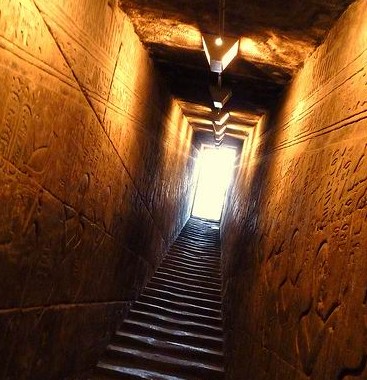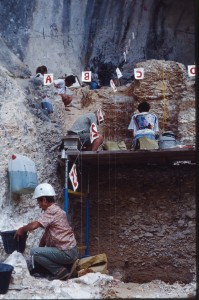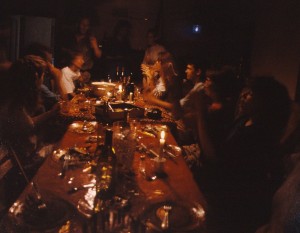 Most archaeologists I know have a soft spot for Indiana Jones. They might not admit it. They might grimace at the famous bullwhip and guffaw at all the suspension-bridge antics over crocodile-infested waters. But despite that, or perhaps because of it, Indiana Jones often captures something from a defining moment in their lives. It reminds them—as little else can—of childhood and their Howard Carter/Gertrude Bell dreams of becoming archaeologists, of going it alone, of mastering ancient Egyptian hieroglyphs, of roaming faraway deserts and discovering the golden treasures of ancient kings. Could anything that adults do be more fun?
Most archaeologists I know have a soft spot for Indiana Jones. They might not admit it. They might grimace at the famous bullwhip and guffaw at all the suspension-bridge antics over crocodile-infested waters. But despite that, or perhaps because of it, Indiana Jones often captures something from a defining moment in their lives. It reminds them—as little else can—of childhood and their Howard Carter/Gertrude Bell dreams of becoming archaeologists, of going it alone, of mastering ancient Egyptian hieroglyphs, of roaming faraway deserts and discovering the golden treasures of ancient kings. Could anything that adults do be more fun?
At the end of this month, Montreal Science Centre is hosting the world premiere of an exhibit entitled Indiana Jones and the Adventure of Archaeology. On display will be props and models from the George Lucas movies as well as some lovely ancient eye candy from the collections of the University of Pennsylvania Museum. The exhibit will surely draw huge crowds, including, I suspect, most archaeologists from the region.
What I find fascinating though is how little this childhood dream matches the very real, very adult pleasure of working in the field. It’s a pleasure that has little to do with adrenaline, and much to do with other kinds of human chemistry. It’s the pleasure of living in a remote place with a band of strangers; of cooking and dining together, sometimes by candlelight; of sharing hard, uncomfortable work and long hours; of living rough and sleeping under one large roof or in a tent city; of sharing showers, sometimes sharing sleeping bags, and often sharing the local brand of turista. Above all else, it’s the pleasure of working together towards a common, passionately held purpose. It has little or nothing to do with rugged individualism.
Indeed, the best field camps resemble the hippie communes of old, and I mean that in the best possible sense. Over a month or two of summer, a kind of tribalism flowers, an intoxicating blend of intimacy and camaraderie that forges lifelong bonds between fellow students. I think this is why archaeologists so often marry other archaeologists. And it’s why former students become such enduring friends with their profs. And I know it’s why archaeologists are so often so reluctant to pack up camp at the end of the season and head back to the real world. They hate to leave that kind of magic behind.
 One of the best field camps I ever visited was in Provence. Based in an old rambling rented French farmhouse, the team set off each morning in a small convoy of dusty vehicles, hairpinning down the side of a narrow gorge in one of the last wildernesses in France: all the while, The Clash blasted from a car stereo. The gorge seemed forgotten—we never saw as much as another soul there, no hikers, no buildings, no sign of the modern world at all. But near the bottom lay a rockshelter, a huge shadowy gouge in the limestone where Neanderthal bands frequently spent the night some 35,000 years ago. Surrounded by a silent sea of greenery, I felt as if the Neanderthals could return at any moment.
One of the best field camps I ever visited was in Provence. Based in an old rambling rented French farmhouse, the team set off each morning in a small convoy of dusty vehicles, hairpinning down the side of a narrow gorge in one of the last wildernesses in France: all the while, The Clash blasted from a car stereo. The gorge seemed forgotten—we never saw as much as another soul there, no hikers, no buildings, no sign of the modern world at all. But near the bottom lay a rockshelter, a huge shadowy gouge in the limestone where Neanderthal bands frequently spent the night some 35,000 years ago. Surrounded by a silent sea of greenery, I felt as if the Neanderthals could return at any moment.
The field team, mostly students from Quebec in their early twenties, worked with a rare concentration and seriousness. Yet day in and day out, they struggled to free butchered animal bones—the Neanderthals’ tablescraps—from a cementlike matrix known as brecchia that had accumulated when water flowed through the porous limestone. The students pried their way through this with dental picks. But no one complained, no one played hookie. They all knew that Serge Lebel, the senior archaeologist, had been searching for years for Neanderthal remains in the shelter and they dreamed of finding those bones. Decades earlier, another team had recovered a Neanderthal tooth from these deposits. Could the rest of the skeleton be far off?
The last day I was there, a loud whooping broke out on the far side of the shelter. Lebel, who taught at the University of Quebec in Montreal, hurried over. There in a student’s square was a small, darkened tooth erupting from the brecchia. Lebel stared at it for a time. Then he worried it loose from the deposit, cradled it in the palm of his hand, and turned it over, examining it as if it were a crown jewel. It was a hominin tooth, he finally declared, as the entire field crew looked on. Probably, very probably, Neanderthal.
 At dinner that night, Lebel cracked open a case of a very fine Chateauneuf du Pape that he had stowed away for just such an occasion. And one by one, the field crew rose from their chairs at the long wooden table, warmly thanking their teammates, thanking Lebel, thanking the Neanderthal who slept still in the Gorge de la Nesque for one of the greatest experiences of their lives. It sounded to me as if they really meant it.
At dinner that night, Lebel cracked open a case of a very fine Chateauneuf du Pape that he had stowed away for just such an occasion. And one by one, the field crew rose from their chairs at the long wooden table, warmly thanking their teammates, thanking Lebel, thanking the Neanderthal who slept still in the Gorge de la Nesque for one of the greatest experiences of their lives. It sounded to me as if they really meant it.
The next morning, I packed my bags for the long trip home. I hated to leave.
Photos: Upper, the Temple of Edfu, courtesy The World According to Marty. “Walking this corridor,” the photographer wrote, “reminded me of all those times I’ve watched Indiana Jones.” Middle: Bau de l’Aubesier rockshelter in Provence, France, Heather Pringle. Bottom: Celebration of field crew, courtesy Pierre St. Jacques.
I spent a week once on a mountain with a crew dismantling a telescope so they could send the mirror to be polished. It was exactly the feeling you described, though maybe less intense since this crew went home every night and worked like this all year round. The morning I left, I wondered how they were going to do without me — not that I was in any way useful, I can’t quite explain it, something like the group would now have a part missing. Very odd, also addictive.
Yes, these experiences are probably very common to field crews working in many scientific disciplines. Isolation, hard work under difficult circumstances, and a passion for science surely breed this kind of addictive intimacy, no matter if you’re a geologist, astronomer or biologist. I’ve been to some truly terribly field camps, too. Perhaps that’s the subject for another post, though.
Beautiful. I feel like I was actually there.
Heather, thank you for sharing with us! I agree with Evanstonian in that you made me feel as if I was there. While a minor detail, and barring any local spellings, I believe the rock is spelled breccia and the matrix comprises the breccia. Thanks again for the great writing.
Travis